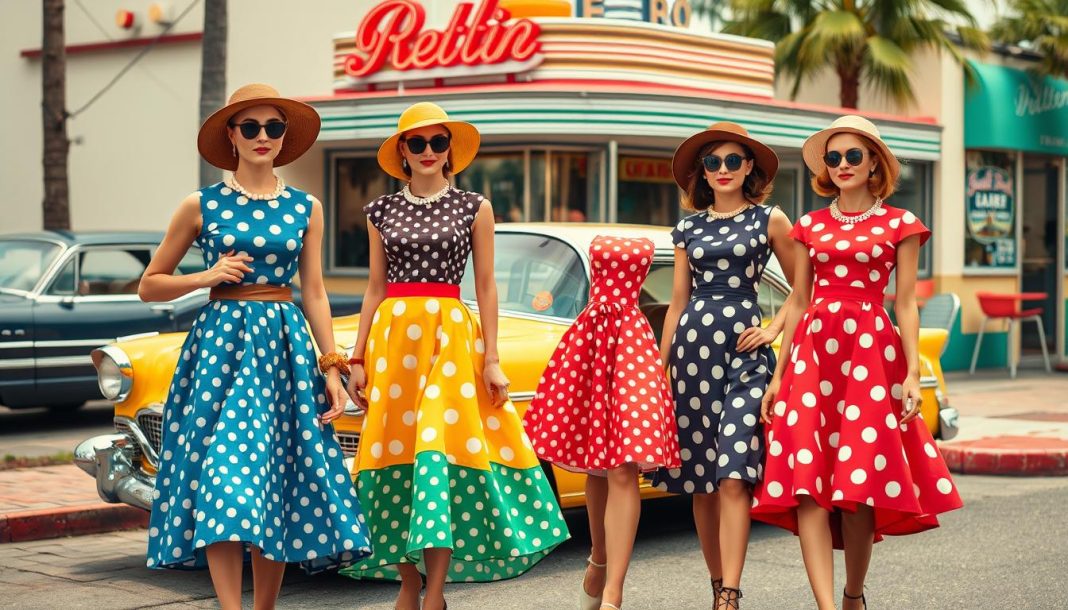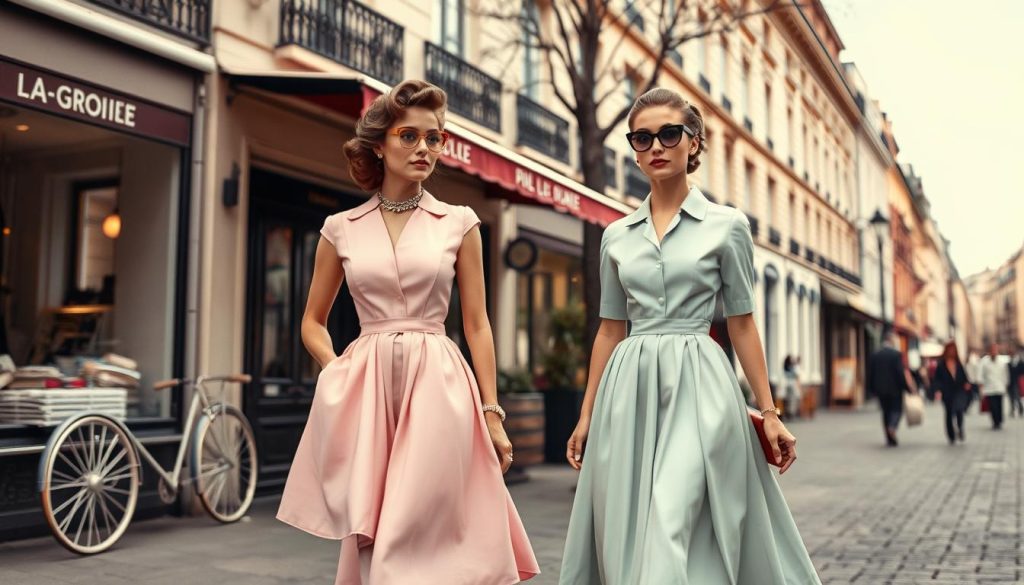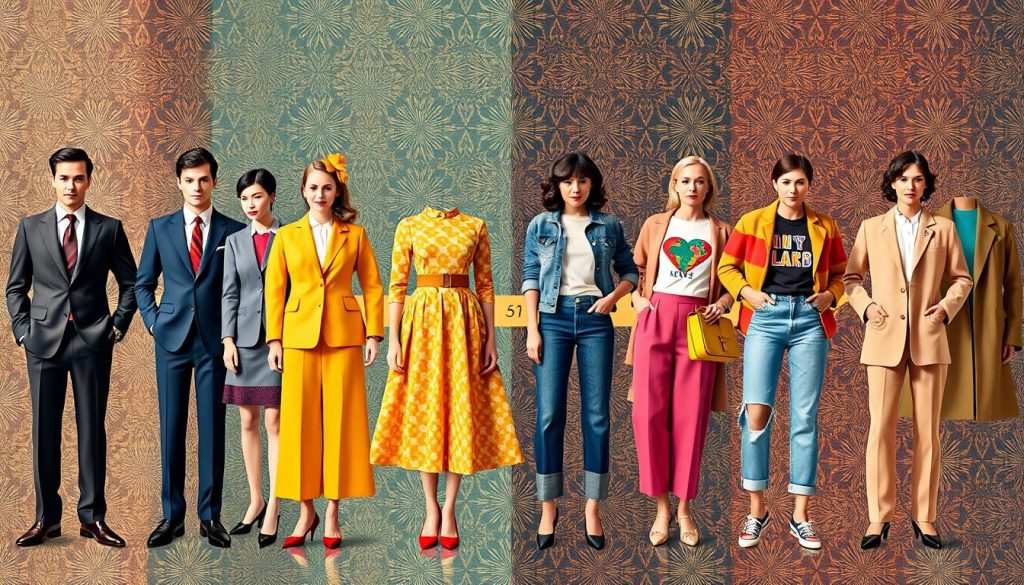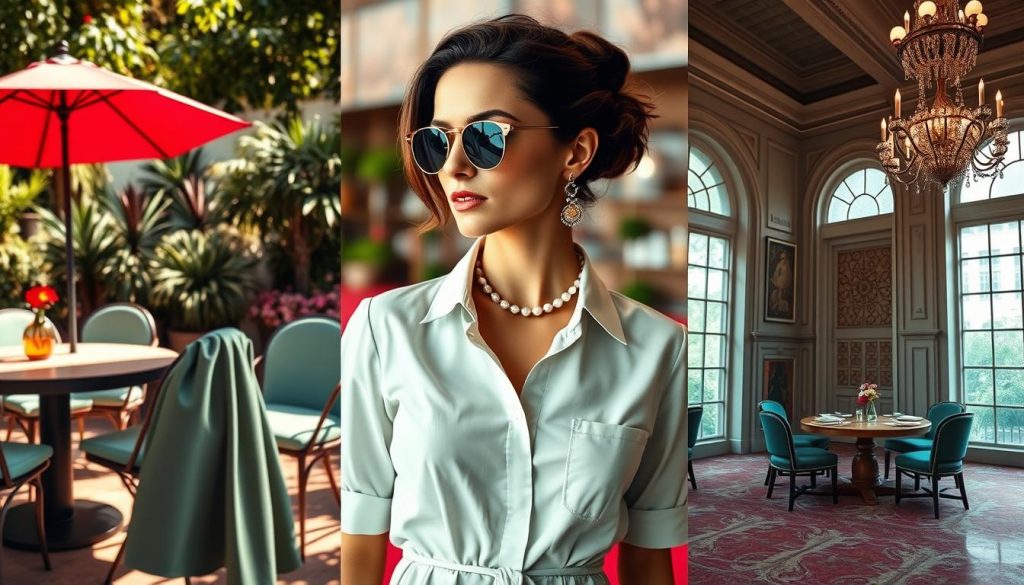The ’50s hold a special charm that still captivates us today. The classic styles from this era embody timeless elegance.
They blend perfectly with current trends. This decade sparked a fashion revolution, introducing vibrant colors and new silhouettes. These styles transcend time, offering a mix of nostalgia and freshness.
The ’50s celebrated fashion diversity, offering styles that reflected personal identities. It was a time when teen culture emerged, shifting fashion towards more youthful designs.
Textile tech advances and synthetic materials made clothes more affordable and durable. This change made fashion available to everyone, supporting a variety of looks.
Thanks to higher living standards and inventions like the washing machine, maintaining fashionable clothes became easier. This era set the stage for the chic retro look and casual styles.
These styles inspired subcultures like pin-up and rockabilly.
Modern fashion often draws from the ’50s, mixing classic elements with new designs. This proves that some styles are indeed timeless.
As we move forward, the elegance of the past remains with us. It effortlessly blends into today’s fashion, enriching it.
Exploring the Playful and Diverse World of 50s Fashion
The 1950s were a colorful time for fashion. They brought big changes in style and who wore it. This era introduced vibrant 50s clothing and a new focus on young people’s fashion. It also saw the start of leisurewear evolution, making everyday outfits more fun, comfy, and bold.
The Birth of Teen Culture and Leisurewear
In the 1950s, teens started to stand out in the fashion scene. They had more money to spend than before. This led them to embrace unique styles that had a big impact on leisurewear evolution. Boys liked Hawaiian shirts and bomber jackets. Girls were seen in poodle skirts and saddle shoes. This was a shift from the usual adult clothing, showing that young people wanted to look cool and be comfortable.
Affordable Clothing and Improved Living Standards
After the war, the ’50s brought better living and new textiles. Materials like nylon and polyester became popular. They were improved garments maintenance. Clothes were stylish but easy to take care of, thanks to these fabrics. This made cool clothing affordable for more people. It helped vibrant 50s clothing become well-liked. Now, everyone could look good without a lot of fuss.
In short, the 1950s changed fashion a lot. They introduced teen styles and better fabric technology. This change made clothes better and more colorful. It had a big effect on how people dress for fun and comfort today.
Christian Dior’s ‘New Look’ and Its Lasting Influence
In 1947, a big change came to haute couture with Christian Dior’s ‘New Look’. It introduced rounded shoulders, cinched waists, and big A-line skirts. It became a sign of femininity and luxury worldwide. After WWII, people wanted colorful and elegant clothes. Dior’s designs were the answer.
Dior’s New Look loved the hourglass shape, unlike the practical wartime clothes. It brought back luxury and made Paris the fashion capital again. The change was huge. We went from simple clothes due to fabric rationing to outfits that showed wealth and creativity.
| Year | Collection | Key Features |
|---|---|---|
| 1947 | New Look | Cinched waist, full skirt, soft shoulders |
| 1952 | Profile Line (La Cigale) | Structured silhouette, heavy fabrics |
| Throughout 1950s | Variations | Adjustments to skirt line and length |
The New Look used a lot of fabric for each skirt. It symbolized freedom and recovery from the tough war years. Dior’s ideas helped the French fashion scene. They also made fancy fashion popular and achievable for many women.
Dior also brought back old techniques to highlight women’s natural curves. This started a new age of romantic and fancy femininity. Even now, Dior’s New Look shapes today’s fashion. It shows that great style never goes out of fashion.
Hollywood Glamour and Its Fashion Icons
The 1950s was a special time for fashion, mostly because of Hollywood. This era showed off a strong Hollywood fashion influence around the world. It was famous for its style, thanks to some 50s film icons. These stars became fashion symbols, just like their roles in movies.
Marilyn Monroe and Jane Russell were huge fashion stars. They were known for their stunning outfits. Both on screen and in real life, they showed off the designer elegance of that time. This made them timeless vintage celebrity styles icons.
Marilyn Monroe and Jane Russell: Style Personified
Marilyn Monroe’s bold yet effortless fashion sense mixed with Jane Russell’s classic beauty set trends. They made fur wraps and beautiful gowns must-haves for glamour, thanks to their Hollywood look.
Key Designers of the 1950s Era
Designers like Christian Dior, Hubert Givenchy, and Cristóbal Balenciaga were stars too. They dressed famous people and changed fashion with new ideas. Their designs made waves during the Golden Age of Paris Couture. They introduced styles like the A-line and ‘New Look,’ changing women’s fashion worldwide.
Christian Dior was always creating new styles until he passed away in 1957. But his fashion ideas lived on. For instance, the stiletto heel, which came out while he was in charge, became a big deal for the era.
The evolution and connection between 50s Hollywood and these famous designers created a lasting fashion image. It still affects how we see style today.
| Icon | Signature Style | Influence On Fashion |
|---|---|---|
| Marilyn Monroe | Fur wraps, evening gowns | Hollywood glamour |
| Jane Russell | Elegant dresses | Sophisticated vintage appeal |
| Christian Dior | New Look, A-line | Hourglass silhouette popularity |
The Evolution of Work Attire and Casual Styles
The fashion evolution from the 1950s to now shows big changes in menswear and womenswear. What started with 50s suits has moved to a more casual look. This reflects broader cultural changes.
In the 1950s, men’s fashion was mostly gray at work. It showed a sleek, narrow look that fit the post-war office scene. This era’s menswear wasn’t just about style. Learn more about work clothing history.
It was also about being practical thanks to ready-to-wear clothes. These made men’s clothing more uniform and easy to get.
Women’s work clothes in the 1950s changed too. They wore tailored jackets and different skirt styles. These clothes mixed practicality with a touch of elegance. This was different from the past’s more practical styles.
In casual wear, the ’50s saw big changes. Men’s leisure clothes got more colorful versus the gray suits. Women’s casual clothes became less tight. This shifted everyday fashion to more casual and practical looks.
Work clothes keep changing, mixing old fashion evolution with today’s need for comfort and style. See how styles keep changing.
Post-pandemic, comfort is key in fashion. Yet, it nods to past styles. This shows fashion’s cycle: always taking from the past and adding new twists.
Women’s Fashion: From Home to High Society
The 1950s were a time when women’s roles changed a lot. They had many different roles in society. Their fashion choices showed these big changes after World War II. One key piece was the shirtwaist dress. It brought together practicality and style, perfect for home and fancy events.
The Iconic Shirtwaist Dress and Its Versatility
The shirtwaist dress became a big part of women’s 50s attire. It had a snug top, tight waist, and wide skirt. This shape made women look more feminine and made moving around easy. It was great for handling house duties or going to social events.
The shirtwaist dress was popular for its flexibility. With simple pieces, it worked for staying home. Or, with pearls and heels, it was perfect for an evening out. This made it a must-have for women in the 1950s. It showed the main idea of fashion versatility back then.
Tailored Suits to Feminine Accessories: A 50s Staple
Tailored suits also became a symbol of high society style. Inspired by Dior’s New Look, these suits had tight waists and wide shoulders. They gave off a powerful and stylish vibe. This became the go-to look for women aiming high. Accessories like gloves, hats, and jewelry were key too. They weren’t just for looks but showed a woman’s rank and fashion sense. They could change an outfit from daywear to fancy night clothes.
The move from basic, practical wartime clothes to fancy materials and distinct shapes marked a decade of fast fashion changes. Women in the 1950s used their clothes to show who they were and their place in society. This time wasn’t just about new styles. It also changed women’s roles in society, making it a key time for women’s fashion history.
Conclusion
The 1950s fashion scene was a clear bridge from the 40s austerity to the 60s freedom. It has left an enduring legacy that shines in today’s fashion. The era’s fashion revival shows us how the 50s style influence shapes current trends. Icons like Christian Dior’s “New Look” and Coco Chanel’s tweed suits have fueled a vintage fashion resurgence we still enjoy.
The 1951 Festival of Britain Exhibition showcased luxury, while Marks & Spencer offered cozy knitted dresses. Back then, materials like acrylic and nylon were new, changing fashion’s texture and feel. The era’s signature look of cinched waists and full skirts combined rebirth with elegance.
In the 50s, everyone explored the style, from Jacques Fath’s swing coats to Marilyn Monroe’s dresses. It was a time for women to express their femininity freely, breaking free from wartime limits. Every piece of clothing from that period carries its story into today. By wearing 50s inspired dresses to parties and tweed to work, we keep the charm of 50s fashion alive. It’s a celebration of joy, identity, and beauty that remains timeless.





